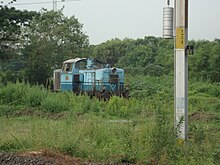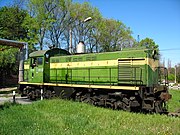Switcher locomotive
This article has multiple issues. Please help improve it or discuss these issues on the talk page. (Learn how and when to remove these messages)
|

A switcher, shunter, yard pilot, switch engine, yard goat, or shifter is a small railroad locomotive used for manoeuvring railroad cars inside a rail yard in a process known as switching (US) or shunting (UK). Switchers are not intended for moving trains over long distances but rather for assembling trains in order for another locomotive to take over. They do this in classification yards (Great Britain: marshalling yards). Switchers may also make short transfer runs and even be the only motive power on branch lines and switching and terminal railroads. The term can also be used to describe the workers operating these engines or engaged in directing shunting operations.
The typical switcher is optimised for its job, being relatively low-powered but with a high starting tractive effort for getting heavy cars rolling quickly. Switchers are geared to produce high torque but are restricted to low top speeds and have small diameter driving wheels. Switchers are rail analogs to tugboats.
US switchers tend to be larger, with bogies to allow them to be used on tight radiuses. European shunters tend to be smaller and more often have fixed axles. They also often maintained coupling rods for longer than other locomotive types, although bogie types have long been used where very heavy loads are involved, such as at steelworks.
Switching is hard work, and heavily used switch engines wear out quickly from the abuse of constant hard contacts with cars and frequent starting and stopping.[citation needed]. Nevertheless, some types (like the Swedish class U) have been remarkably long-lived.
Power types
Diesel

Diesel switchers tend to have a high cab and often lower and/or narrower hoods (bonnets) containing the diesel engines, for all round visibility. Slugs are often used because they allow even greater tractive effort to be applied. Nearly all slugs used for switching are of the low hood, cabless variety. Good visibility in both directions is critical, because a switcher may be running in either direction; turning the locomotive is time-consuming. Some earlier diesel switchers used cow-calf configurations of two powered units in order to provide greater power.
Electric

The vast majority of modern switchers are diesels, but countries with near-total electrification, like Switzerland, use electric switchers. Prior to the introduction of diesel-electric locomotives, electric shunting locomotives were used to an extent in Great Britain where heavy trains needed to be started on steep gradients. The steeply-graded Quayside Branch in Newcastle upon Tyne was electrified by the North Eastern Railway in 1905, and two steeplecab locomotives were built to handle all traffic on the line. One of these, No. 1, is now part of the National Collection and resides at Locomotion in Shildon. On the opposite side of the Tyne, the electrified lines owned by the Harton Coal Company in South Shields for the movement of coal and colliery waste to shipping facilities on the river was one of the more extensive industrial networks. A number of the early German locomotives built for use on these lines have been preserved. Electric locomotives were also extensively employed for moving the coke cars at cokeworks, obtaining power from a side wire, as third rail or overhead line electrification would have been impractical. These specialised locomotives were tall steeple-cab types not seen anywhere else, and operated on a short length of track between the ovens and the quenching tower. Despite their ubiquity, very few have survived into preservation as there is very little scope of operating them due to their unique means of obtaining power, slow speed and the fact they greatly exceed the loading gauge of most railway lines. One example built by Greenwood and Batley in Armley, Leeds is preserved at the Middleton Railway, not far from where it was built.
Small industrial shunters are sometimes of the battery-electric type. An early battery-electric shunting locomotive is shown here.[1] The Tyne and Wear Metro has three battery electric shunters built by Hunslet, which are used to haul engineering trains when the overhead supply is switched off. New Zealand Railways imported and manufactured locally battery-electric shunters in the 1920s: the EB class and the E class (1922)
Flywheel energy storage was also used experimentally by Sentinel.
Three power
The "GE three-power boxcab locomotive" was a type of switcher developed in the USA in the 1920s. It was a diesel-electric locomotive which could alternatively run on batteries (for use inside warehouses) or from a third rail or overhead supply.[2] It was a type of electro-diesel locomotive.
Steam

Steam shunter/switchers are now mainly of historical interest. Steam switchers were either tank locomotives or had special (smaller) tenders, with narrow coal bunkers and/or sloped tender decks to increase rearward visibility. Headlights, where carried, were mounted on both ends. Most were either side-tank or saddle-tank types, however in the usual departure from its neighbours' practice, the Great Western Railway used pannier tanks for shunting and branch line work, a practice which the Western Region of BR perpetuated until steam traction was phased out, with several examples joining a 9F as banking engines to assist locomotives on the notoriously arduous ascent of the Lickey Incline, replacing the LMS "Jinties" which had formerly carried out the task alongside "Big Emma".
As diesel shunters began to appear in ever-increasing numbers, attempts were made by companies such as Sentinel to adapt the vertical boilers from their steam powered road vehicles for use in shunting locomotives, in order to compete with the newcomers. Although these were found to be equal in power and efficiency to most of the early diesel designs, their development came too late to have any real impact. Outwardly, they bear more resemblance to diesels than steam locomotives. A number have been preserved on heritage railways, although few of these are in working order, being designed very specifically for shunting work and lacking the necessary speed to travel any kind of distance.
Small industrial shunters have sometimes been fireless locomotives and a few of these are still at work in Germany. Again, several have been preserved, but are mostly static displays, as heritage railways and museums lack the large source of high-pressure steam (such as a power station's boilers) needed to charge the locomotive's accumulator.
Non-US shunters


British and European locomotives of this type tend to be much smaller than the common size in the United States. Current British shunters are 0-6-0 diesel-electrics, Class 08 and Class 09, of 350-400 horsepower. These were developed from similar locomotives supplied by the English Electric Company to the Big Four British railway companies in the 1930s and 1940s, e.g. those pioneered by the LMS. Similar locomotives were exported to the Netherlands (e.g. NS Class 600) and Australia (e.g. Victorian Railways F class (diesel)). The use of shunting locomotives saw a sharp decline in Britain in the latter half of the 20th century, largely due to the contraction of the network, increased competition from road traffic and widespread adoption of train-load freight, with fixed rakes of wagons moving mainly bulk products between rapid-loading facilities, as opposed to thousands of sidings and goods depots feeding trains of assorted wagons into the marshalling yards.
In continental Europe 0-6-0 (or "C") diesel-hydraulics, similar to the short-lived British Rail Class 14, are widely used. A very common type is the DB Class V 60 and its variants. Two examples on the Turkish State Railways are TCDD DH33100 and TCDD DH7000. For lightweight shunting of single wagons or short trains, two-axle shunters are common; in Germany these are known as Kleinlokomotive (small locomotive).

Sri Lanka Railways owns 28 Class Y shunters in operation. However Class Y1 is not in operation.
| Class | Wheel Arrangement | Horse Power | Manufacturer | Engine | Transmission | Livery | Imported Year |
|---|---|---|---|---|---|---|---|
| Y | 0-6-0 | 530 | Hunslet | Rolls Royce V8 | Hydraulic | Black | 1969 |
| Y1 | 0-8-0 | 1150 | Locally Assembled | Paxman V12 | Hydraulic | Blue & Red | 1972 |
| G1 | 0-4-0 | 122 | Armstrong Whitworth | Saurer | Electric | Black | 1934 |
| G2 | Bo-Bo | 625 | North British | Paxman V8 | Electric | Black | 1948 |
| ML1 | B | 132 | Locally Assembled | Tata | - | - | - |
Station pilot

A station pilot is a shunting engine based at a major passenger station, used for moving trains or carriages between platforms, assembling trains, and other passenger train shunting tasks. Having assembled a train, it could also be used to assist the train engine in starting a train by pushing from behind. It is a predominantly British term.
Station pilots have recently been phased out in the UK as the majority of passenger trains are formed with multiple units or have a Driving Van Trailer at the opposite end to the locomotive; the few locomotive-hauled passenger trains are shunted by the train engine rather than a dedicated station pilot.
The British Rail Class 03 was commonly seen performing this duty, having gradually replaced the assortment of four and six-coupled tank engines which had previously been used.
Shed/works pilot
Pilot locomotives are now limited to use in locations such as traction maintenance depots and heritage railways to move rolling stock and "dead" locomotives in and out of the buildings. The National Railway Museum in York, England, uses a Class 08 for this purpose, as does Heaton TMD near Newcastle upon Tyne. Locomotives performing this particular duty were traditionally known as shed pilots when working at a motive power depot, and as works pilots when shunting at locomotive, carriage or wagon works. On heritage railways, where there is not enough work for the shed pilot to justify the cost of keeping even a small locomotive in steam all the time, diesel shunters usually act as shed pilots. At the Tanfield Railway near Gateshead, a four-coupled Armstrong Whitworth diesel-electric shunter of 1933 vintage generally performs pilot duties. On other heritage railways, a number of preserved Class 03 and Class 08 shunters have been given a new lease of life as shed pilots, making the Class 03s some of the few preserved locomotives whose regular duties remain largely the same as those they were used for prior to preservation. Many other heritage railways also use diesel mechanical shunting locomotives from the likes of Ruston or North English, some as small as 88 hp.
Gallery
-
ChME3 is a Czech built diesel–electric switcher, operated by Ukrainian Railways
-
RailPower Railpower GG20B Green Goat
-
A China Railways DF7G shunting the carriages of Beijing–Kowloon through train at Beijing West railway station
-
British Rail 08833 in "Liverpool Street Pilot" duties
-
Class Y Hunslet Diesel Shunter Operated By Sri Lanka Railways
-
DF5 Diesel Shunter Operated By Korean State Railway
See also
- Hydrail switcher
- Road switcher
- Rail car mover - some of which resemble HiRail trucks
- Road-rail vehicle
- Tugboat, marine analog
- Terminal tractor, road equivalent
- Unimog
References
- ^ "Electric locomotive, 1917". Ingenious. UK. Archived from the original on 28 March 2016. Retrieved 14 May 2016.
- ^ "unknown". Archived from the original on July 1, 2009.
{{cite web}}: Cite uses generic title (help)
- "Diesel Railcars & Shunters". The Model Railroad Club of Sri Lanka. Retrieved 15 May 2016.
- "Diesel Locomotives of Sri Lanka – Locomotive classification". Archived from the original on 28 December 2012.












